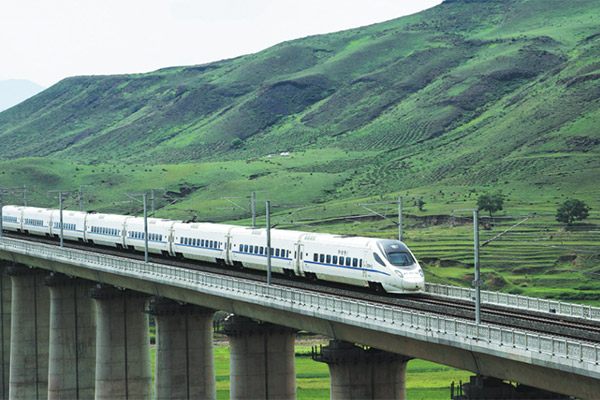
A high-speed train heads to Ulanqab from Hohhot in the Inner Mongolia autonomous region in August, marking the opening of the region’s first high-speed railway.[Photo/China Daily]
Passengers can now reach most of China’s major cities by bullet train, thanks to a network that includes linkages of a number of rail routes, as well as efficient major transfer hubs.
According to China Railway Corp, the national rail operator, direct high-speed train services have been arranged between cities with a large number of passengers, including Beijing-Kunming, Harbin-Shanghai and Chengdu-Guangzhou. Those direct services link big cities in different regions by taking more than one rail route.
Service between Dalian, Liaoning province, and Xi’an, Shaanxi province, involves eight high-speed rail routes that link 18 medium-size and large cities.
Running the network is no easy task. A high-speed rail route must not only carry out bullet train services running only on a single line but also on multiple lines.
The major transfer hub design allows easy transfers to other bullet trains. Passengers can make travel plans and buy connected tickets in advance. When they arrive at the transfer station, they can use a transfer gateway to board the next service, with no need to exit the gate and enter again. The major transfer hub design offsets the lack of direct service in some areas, providing more convenient travel choices.
Lanzhou West station, the major transfer hub linking the Xinjiang Uygur autonomous region with the rest of China, is expected to receive more than 5,000 transfer passengers a day, said Wang Jian, the deputy head of the station. The Baoji-Lanzhou rail route opened in July, and Wang estimates daily passengers will reach 25,000. The route links Lanzhou with the high-speed rail network.
No direct service links Xinjiang with most cities beyond Lanzhou. A passenger from Beijing can take a direct service to Lanzhou and then transfer at Lanzhou West station to Xinjiang.
China’s high-speed rail network has surpassed 20,000 kilometers, spanning all provincial level regions except Tibet and the Ningxia Hui autonomous region. Hub cities are scattered around the country and linked by the high-speed network.
The world’s longest high-speed rail service in operation is the 2,760-kilometer Beijing-Kunming service, according to China Railway Corp. Beijing has a distinct spring, summer, fall and winter, whereas Kunming has been called “the spring city” because the weather never gets very cold.
Like the Beijing-Kunming service, departure and arrival cities are different, requiring a different model of bullet train to adjust to diverse local environment.
In the northeastern region’s winter, when the lowest temperature can hit -40 C, bullet trains need to adjust. In the northwest region’s deserts, featuring strong winds and sandstorms, such as along the Lanzhou-Xinjiang line, bullet trains have stormproof designs.
According to a plan released by the National Development and Reform Commission in July 2016, China will expand the high-speed rail network to 30,000 km by 2020, linking 80 percent of major cities. By 2030, the network will link all cities with populations of more than 500,000.
